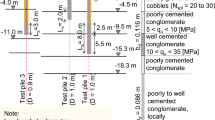In this study, we conducted three-dimensional finite element analysis of the uplift bearing capacity of rock-socketed piles using ABAQUS FE software. After verifying the reliability of the numerical model, a large number of numerical calculations were performed by varying parameters including rock-socketed depth, pile length, pile diameter, and elastic modulus of the pile shaft to analyze their effect on the uplift bearing capacity. The results show that the relationship between uplift load and displacement of a rock-socketed pile consists of three stages: an elastic deformation stage, an elastoplastic deformation stage, and a plastic failure stage. The uplift bearing capacity increases with increasing rock-socketed depth, pile length, and pile diameter. As rock-socketed depth increases, the proportion of frictional resistance to uplift load increases nonlinearly. With increasing of elastic modulus of the pile shaft, the ultimate uplift bearing capacity of a rock-socketed pile increases, whereas the pile-top displacement decreases.
Similar content being viewed by others
References
W. D. Wang, Q. P. Weng, and J. B. Wu, “Design and analysis of the deep substructures uplift piles in the project of Shanghai World Exposition 500 kV underground electric substation,” Build. Struct., 37(5), 107-110 (2007).
B. C. Chattopadhyay and P. J. Pise, “Uplift capacity of piles in sand,” J. Geotech. Eng., 112(9), 888-903 (1986).
G. G. Meyerhof and J. I. Adams, “The ultimate uplift capacity of foundations,” Can. Geotech. J., 5(4), 225-244 (1968).
B. M. Das, “A procedure for estimation of uplift capacity of rough piles,” Soils Found., 23(3), 122-126 (2008).
K. Shanker, P. K. Basudhar, and N. R. Patra, “Uplift capacity of single piles: prediction and performance,” Geotech. Geol. Eng., 25(2), 151-161 (2007).
Q. Su, X. X. Zhang, P. B. Yin, and W. H. Zhao, “Ultimate capacity analysis and determination of the position of failure surface for uplift piles,” Math. Probl. Eng., 2, 1-6 (2014).
R. Nazir, H. Moayedi, A. Pratikso, and M. Mosallanezhad, “The uplift load capacity of an enlarged base pier embedded in dry sand,” Arab. J. Geosci., 8(9), 7285-7296 (2015).
K. E. Gaaver, “Uplift capacity of single piles and pile groups embedded in cohesionless soil,” Alexandria Eng. J., 52(3), 365-372 (2013).
K. Faizi, D. J. Armaghani, H. Sohaei, A. S. A. Rashid, and R. Nazir, “Deformation model of sand around short piles under pullout test,” Measurement, 63, 110-119 (2015).
Z. M. Zhang, Q. Q. Zhang, and Y. Yu, “A destructive field study on the behavior of piles under tension and compression,” J. Zhejiang Univ.-SCI A., 12(4), 291-300 (2011).
H. F. Liu, C. Q. Zhu, X. Cui, Q. S. Meng, and W. J. Wu, “Experimental research on end bearing characteristics of rock-socketed pile in reef limestone,” Chin. J. Rock Mech. Eng., 37(S2), 4348-4355 (2018).
B. Yang, J. L. Ma, D. F. Lin, W. T. Zhang, and Z. M. Sun, “Field test study on uplift characteristic of rock-socketed piles,” Railw. Eng., 58(7), 87-91 (2018).
J. L. Yu, S. Q. Zhang, L. Y. Chen, J. L. Ai, G. Leng, K. S. Luo, M. H. Huang, and J. Y. Yang, “Test and numerical analysis on uplifting and bearing performance of rock-socketed piles with equal sections,” J. Nanchang Hangkong Univ., 32(3), 19-25 (2018).
C. H. Zhang, Q. H. Zhao, C. Lou, and H. H. Mo, “Model experimental study of rock socketed pile in slope strata subjected to horizontal loading,” J. Eng. Geol., 27(2), 286-293 (2019).
T. Gao, C. B. Zhou, X. Y. Zhou, T. Wang, and X. M. Zeng, “Model test of influence of sediment on bearing capacity of pile socketed in soft rock,” Saf. Environ. Eng., 26(1), 198-202 (2019).
H. Q. Liu, “Numerical analysis of rock socketed pile,” J. Railw. Sci. Eng., 15(10), 2535-2540 (2018).
M. Zhu, Z. M. Sun, H. Zhang, and Y. J. Wang, “Numerical simulation analysis on mechanical characteristics of rock socketed piles with variable cross section of iron tower in transmission line,” Subg. Eng., No. 4, 95-99 (2018).
Y. Y. Wang, S. L. Zhou, and D. Liao, “Analysis of vertical bearing capacity of slope rock-socketed pile in port engineering in mountainous river,” Port Waterw. Eng., No. 3, 166-172 (2018).
M. S. Huang, Q. Ren, W. D. Wang, and Z. Chen, “Analysis for ultimate uplift capacity of tension piles under deep excavation,” Chin. J. Geotech. Eng., 29(11), 1689-1695 (2007).
T. Xie, W. Z. Yuan, Z. Z. Jiang, and H. X. Tie, “Pile pulling model test study of rock-socketed piles,” Build. Sci. Res. Sichuan, 28(4), 44-46 (2002).
Author information
Authors and Affiliations
Corresponding author
Additional information
Translated from Osnovaniya, Fundamenty i Mekhanika Gruntov, No. 3, p. 10, May-June, 2021.
Rights and permissions
About this article
Cite this article
Li, G., Zhang, J., Liu, J. et al. Study on the Uplift Bearing Capacity of Rock-Socketed Piles. Soil Mech Found Eng 58, 203–208 (2021). https://doi.org/10.1007/s11204-021-09729-9
Published:
Issue Date:
DOI: https://doi.org/10.1007/s11204-021-09729-9




